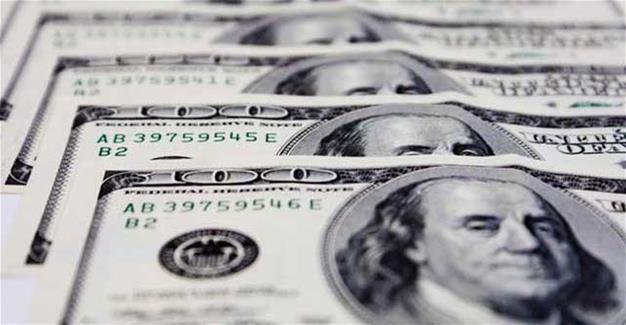US dollar extends gains against Turkish Lira after Fed decision
ISTANBUL
 The U.S. dollar rose sharply against the Turkish Lira late on Sept. 20 after the Federal Reserve unveiled plans to wind down its crisis-era stimulus and hinted at another interest rate hike before the end of the year.
The U.S. dollar rose sharply against the Turkish Lira late on Sept. 20 after the Federal Reserve unveiled plans to wind down its crisis-era stimulus and hinted at another interest rate hike before the end of the year.The U.S. dollar-Turkish Lira index hit 3.52 following the Fed’s decision, while it closed the day at 3.47.
The index rebounded to 3.51 early on Sept. 21.
Markets will have an eye on the latest developments regarding the planned Iraqi Kurdish referendum, which has put pressure on the lira.
After concluding a closely watched two-day policy meeting on Sept. 20, the Fed left interest rates unchanged as expected, but signaled it still expects one more increase by the end of the year despite a recent bout of low inflation.
As anticipated, the U.S. central bank also said it would begin in October to reduce its balance sheet of around $4.2 trillion in U.S. Treasury bonds and mortgage-backed securities it acquired after the 2008 financial crisis.
The greenback extended overnight gains versus yen and euro after the Fed announcement.
New economic projections released after the Fed’s two-day policy meeting showed 11 of 16 officials see the “appropriate” level for the federal funds rate, the central bank’s benchmark interest rate, to be in a range between 1.25 percent and 1.50 percent by the end of 2017, or 0.25 percentage points above the current level.
U.S. bond yields rose, pushing up the U.S. dollar after the Fed’s decision, but U.S. benchmark stock indexes were little changed.
U.S. benchmark 10-year Treasury note yields rose as far as 2.29 percent, the highest since Aug. 8., a move which helped push bank stock prices higher also.
“The Fed took another step on its path of beautiful normalization, announcing that the gradual balance sheet reduction will start next month and limiting revisions to both projections and policy guidance,” said Mohamed El-Erian, Chief Economic Adviser at Allianz, in California, as quoted by Reuters.
In its policy statement, the Fed cited low unemployment, growth in business investment, and an economic expansion that has been moderate but durable this year as justifying it’s decision. It added that the near-term risks to the economic outlook remained “roughly balanced” but said it was “closely” watching inflation.
Inflation outlook ‘mystery’
Fed Chair Janet Yellen said in a press conference after the end of the meeting that the fall in inflation this year remained a mystery, adding that the central bank was ready to change the interest rate outlook if needed.
“What we need to figure out is whether the factors that have lowered inflation are likely to prove persistent,” she said. If they do, “it would require an alteration of monetary policy,” Yellen said.
While the interest rate outlook for next year remained largely unchanged in the Fed’s latest projections, with three rises envisioned in 2018, the U.S. central bank did slow the pace of anticipated monetary tightening expected thereafter.
It forecasts only two increases in 2019 and one in 2020. It also lowered again its estimated long-term “neutral” interest rate from 3.0 percent to 2.75 percent, reflecting concerns about overall economic vitality.
“The US Federal Reserve has firmly signaled that a December rate rise is still on the table,” said Luke Bartholomew, of Aberdeen Standard Investments Investment Strategist in London.
“Clearly the Fed still believes that lower unemployment will eventually translate into a pick-up in inflation, but if inflation continues to undershoot it is hard to see the Fed following through on a hike,” he said.
The U.S. Federal Reserve will resume rate hikes in December and raise borrowing costs three more times in 2018, a Reuters poll found on Sept. 20.
The U.S. central bank will also reduce the size of its asset stock pile by about $1.4 trillion over the next several years as it seeks to restore a normal environment for monetary policy, according to the poll of Wall Street’s top banks taken after the Fed’s latest policy meeting, which ended on Wednesday.
The Fed, as expected, also said it would begin in October to reduce its approximately $4.2 trillion in holdings of U.S. Treasury bonds and mortgage-backed securities by initially cutting up to $10 billion each month from the amount of maturing securities it reinvests.
That action will start a gradual reversal of the three rounds of quantitative easing, or bond buying, the Fed pursued between 2008 and 2014 to stimulate economic growth after the 2007-2009 financial crisis and recession.
The limit on reinvestment is scheduled to increase by $10 billion every three months to a maximum of $50 billion per month until the central bank’s overall balance sheet falls by perhaps $1 trillion or more in the coming years.
Yellen said it would take “a material deterioration” in the economy’s performance for the Fed to reverse a schedule that she expects to proceed “gradually and predictably.”
















